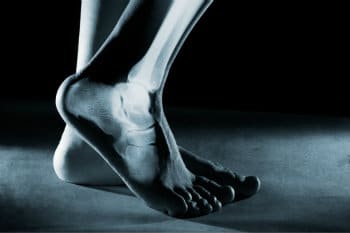HALLUX RIGIDUS - A STIFF BIG TOE

A big toe that can’t move the way it needs to can be disabling not only for athletes, but for everyday people who just want to walk, navigate stairs, or bend over without pain.
Unfortunately, problems with the big toe are more common than you might think. That includes hallux rigidus, a degenerative arthritic condition that affects many of our athletes—especially those who are more middle-aged and with a history of injury.
What Is Hallux Rigidus?
Hallux rigidus is, as we said, a form of degenerative arthritis—and in fact, the most common form of foot arthritis. It affects the joint at the base of the big toe, which is called the metatarsophalangeal joint, or MTPJ.
Hallux rigidus is a progressive condition, and tends to get worse over time.
What Are the Symptoms?
In the earliest stages, the toe may be stiff but still somewhat flexible, and you may experience pain while pushing off with the affected foot. In addition to walking and activity, pain can be triggered by cold or damp conditions.
More advanced cases lead to even more rigidity in the joint, until it can hardly move at all. The pain may become constant—even during rest periods. Bone spurs may develop above and below the joint, leading to pain and difficulty wearing shoes.
Because hallux rigidus impairs your mobility and can change the way you walk, you the pain may spread to your hips, knees, or even back as they try to compensate. Limping may be present in the most severe cases.
What Causes Hallux Rigidus?
A complex mix of factors can increase your risk of developing hallux rigidus. They include:
- Inherited foot structures or acquired deformities. Every foot is different. Some, unfortunately, tend to produce more wear and tear on the MTPJ, which could lead to hallux rigidus. Many things could fit this category. For example, you might have a particularly long big toe, or an elevated metatarsal. Or, you could have flat arches, or severe overpronation.
- Wear and tear / overuse. We specialize in sports medicine, so this is a common underlying factor for our hallux rigidus patients. Running and jumping sports can be to blame, but so can sports or activities that require a lot of squatting—baseball catchers, for example.
- Previous injuries. A specific traumatic injury, such as a stubbed or broken toe or turf toe, could destabilize the joint and accelerate the development of post-traumatic arthritis.
- Medical conditions. In particular, inflammatory diseases such as rheumatoid arthritis or gout have been linked with higher rates of hallux rigidus.
What Can I Do About It?
If you’re experiencing any pain or stiffness in your big toe—especially during sports or other physical activities that are important to you—it is critical to get your feet checked as soon as possible.
In short, the further you let your hallux rigidus progress, the less we may be able to help you.
Conservative Care
In the least serious cases, we may be able to manage your hallux rigidus temporarily with conservative care options.
Unfortunately, conservative treatments really only manage pain. They can’t reverse the damage to the joint, and they usually can’t stop the progression of the condition either (although they may slow it to a degree).
However, if you find that conservative treatments allow you to enjoy your activities and play your chosen sports at a level you are comfortable with, without pain, they may be a good choice in the short term.
Modalities might include:
- Wearing more accommodating shoes or cleats.
- Wearing appropriate sports orthotics.
- Anti-inflammatory medications.
- Heat or ice packs.
- Advanced therapies such as MLS laser treatment, shockwave therapy, prolotherapy, and more. (Ask us about additional options!)
Surgery
If conservative treatments aren’t relieving pain, or you find that the restriction of motion in your toe prevents you from playing to your full potential, surgery may be your best route.
Again, even in cases where surgery must be considered, it’s better to come early with your problem rather than later. If you wait until your hallux rigidus is severe and the cartilage is mostly destroyed, we may need to perform a fusion procedure. This will permanently restrict toe motion. (Although most people can still be active after this surgery, it may make running and jumping more difficult or limited.)
Fortunately, most cases do not come to that. If the damage remains mild or moderate, we can simply remove a portion of bone (and any spurs) to give the toe room to bend. With proper aftercare and rehab, the vast majority of patients find long-term relief and are able to make a full return to their preferred lifestyle within a couple of months.
So stop dragging your feet! At the Colorado Center for Podiatric Sports Medicine, we’ll work hard to fix your hallux rigidus so you can go back to living your best life. Give us a call for an appointment today at (720) 600-3380.
© Colorado Center for Podiatric Sports Medicine | Privacy Policy

